## 使用说明文档
本文档主要介绍了蓝牙专项测试程序的所在仓,如何使用DevEco程序导入该项目,如何预览、编译和烧录该程序以及该程序的功能使用说明。
### 安装使用说明(win环境)
#### 下载代码
1. 文件代码所在仓的地址
[communication_bluetooth: 蓝牙服务组件为设备提供接入与使用Bluetooth的相关接口,包括BLE设备gatt相关的操作,以及BLE广播、扫描等功能。 (gitee.com)](https://gitee.com/openharmony/communication_bluetooth)
2. 下载方式

- 使用git下载
- 安装git。
- 选择一个空文件夹,右键打开git Bash。(文件夹路径中不要出现中文)
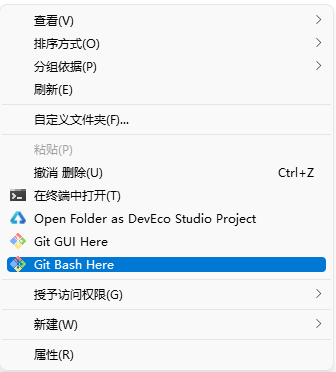
- 使用命令 `git clone {http}`

- 直接下载zip
#### 工具
1. DevEco Studio 3.0 Beta4
- HUAWEI DevEco Studio For OpenHarmony是基于IntelliJ IDEA Community开源版本打造,面向OpenHarmony全场景多设备的一站式集成开发环境(IDE),DevEco Studio 3.0支持在HarmonyOS 3.0 Beta版上开发应用及服务,并已适配ArkUI声明式编程范式、ArkCompiler方舟编译,同时提供低代码开发、双向预览、全新构建工具、模拟器、调试调优、信息中心等功能,为开发者提供工程模板创建、开发、编译、调试、发布等E2E的OpenHarmony应用/服务开发。
2. 下载链接: [HUAWEI DevEco Studio和SDK下载和升级 | HarmonyOS开发者](https://developer.harmonyos.com/cn/develop/deveco-studio#download_beta)
3. 安装步骤: [下载与安装软件-快速开始-HUAWEI DevEco Studio For OpenHarmony使用指南-工具-HarmonyOS应用开发 | HarmonyOS](https://developer.harmonyos.com/cn/docs/documentation/doc-guides/ohos-download-software-0000001218760592)
注:建议在选项界面都勾选DevEco Studio,Add “bin” folder to the PATH,Add "Open Folder as Project"
4. 配置开发环境:[配置开发环境-快速开始-HUAWEI DevEco Studio For OpenHarmony使用指南-工具-HarmonyOS应用开发 | HarmonyOS](https://developer.harmonyos.com/cn/docs/documentation/doc-guides/ohos-setting-up-environment-0000001263160443)
#### 如何导入程序
1. 打开DevEco
2. 在DevEco Studio的欢迎页,选择**Open Project**开始创建一个新工程。
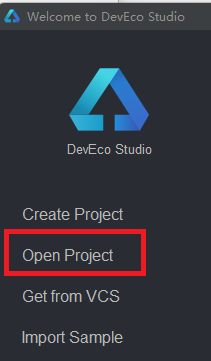
2.选择程序所在的路径
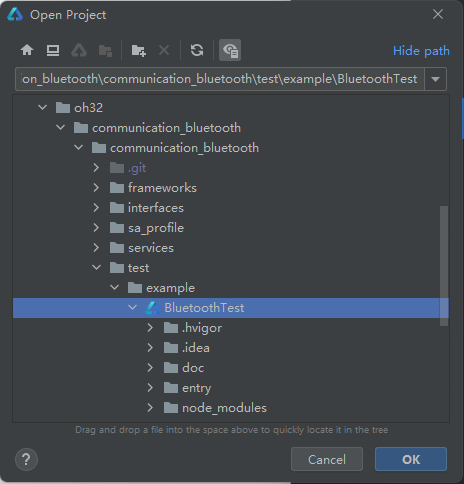
3. 打开程序的homepage
\communication_bluetooth\test\example\BluetoothTest\entry\src\main\ets\MainAbility\pages\homePage.ets
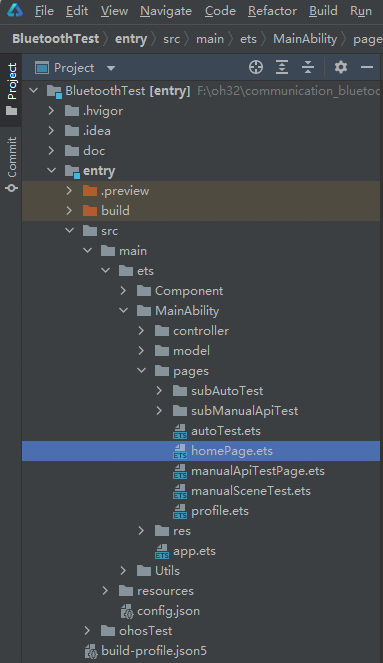
- **entry**为应用的主模块,类似与Android Studio的app模块,一个APP中,对于同一设备类型必须有且只有一个entry类型的HAP,可独立安装运行。
- 使用**previewer**查看程序的预览图
点击View > Tool Windows > Project > Previewer 如下图所示:
- 方法一:
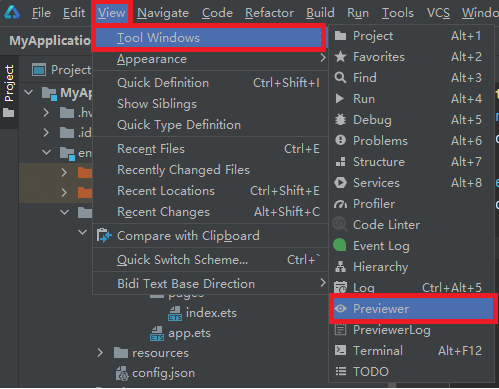
- 方法二:
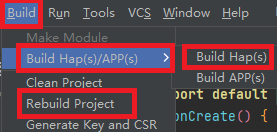
- 成功预览后会生成.preview结构:

- 使用**build**编译程序
- 点击Build > Rebuild 进行编译; Build > Build Hap(s) /App(s) >Build Hap(s) 生成hap文件
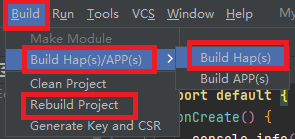
- hap文件的生成路径:entry\build\outputs\default

- 打开homepage点击预览,会显示蓝牙专项测试程序的主界面,如下图所示

注:在预览中,点击具体的功能模块,能实现页面跳转。具体的方法实现,需要在开发板上完成。
- 将搭载OpenHarmony标准系统的开发板与电脑连接。
- 点击File > Project Structure > Project > Signing Configs界面勾选“Automatically generate signature”,等待自动签名完成即可,点击“OK”。如下图所示:
- 为了保证OpenHarmony应用的完整性和来源可靠,在应用构建时需要对应用进行签名。经过签名的应用才能在真机设备上安装、运行、和调试。如果没有配置签名,会报错:hvigor WARN: Will skip sign ‘hap’,Invalid signingConfig is configured for 'default' product.
 程序烧录

---
### 安装使用说明(Open-Harmony)
在开源鸿蒙系统下
- 蓝牙专项应用程序路径为:foundation/communication/bluetooth/test/example/BluetoothTest
- 编译命令
~~~
# 全量编译
./build.sh --product-name {product_name}
# 单独编译HAP
./build.sh --product-name {product_name} --build-target BluetoothTest
- 生成文件
- 使用 find out -name "BluetoothTest.hap*" 查找生成文件,或者直接查看config.json所写的生成路径。
- 将生成文件拷到本地电脑上,连接板子,使用命令 `hdc_std.exe install BluetoothTest`进行安装。
- 使用命令 `hdc_std uninstall {安装包名}` 进行卸载。
- 安装包名在 `entry\src\main\config.json` 如:`"bundleName": "com.ohos.bttest"`
- 补充
在鸿蒙系统下编译,仍存在高版本对低版本的编译不兼容性问题。即在mater版本下编译的hap无法在beta2版本运行;反之则可以。
**要使用Opp文件传输功能,需要添加暴漏接口到本地DevEco的ohos.bluetooth.d.ts,才可以使用opp的接口**
- 修改ohos.bluetooth.d.ts中的 function ` getProfile`
~~~
/**
* Obtains the instance of profile.
*
* @param profileId The profile id..
* @return Returns instance of profile.
* @since 8
*/
function getProfile(profileId: ProfileId): A2dpSourceProfile | A2dpSinkProfile | AvrcpProfile | HandsFreeAudioGatewayProfile | HandsFreeUnitProfile | HidHostProfile | PanProfile | PbapClientProfile |OppProfile | PbapServerProfile ;
- 增加interface `OppProfile`
~~~
/**
* Manager OppProfile profile.
*/
interface OppProfile extends BaseProfile {
on(type: "transferStateChange", callback: Callback): void;
off(type: "transferStateChange"): void;
on(type: "receiveIncomingFile", callback: Callback): void;
off(type: "receiveIncomingFile"): void;
sendFile(device: string, filePaths: Array, mimeTypes: Array): boolean;
setIncomingFileConfirmation(accept: boolean): boolean;
getCurrentTransferInformation(): BluetoothOppTransferInformation;
cancelTransfer(): boolean;
}
~~~
---
### 程序说明
测试模块根据测试类型不同可以分为接口测试,自动化测试,场景测试,Profile测试,性能测试;
根据测试的接口仓不同可以分为bluetooth仓的测试与bluetoothManager仓的测试。
- 接口测试(ohos.bluetooth.d.ts)
>1. 经典蓝牙模块接口测试
>
> Br功能界面使用说明文档.md
>
>2. BLE蓝牙模块接口测试
>
> BLE功能界面使用说明文档.md
>
>3. Gatt模块接口测试
>
> Gatt功能界面使用说明文档.md
>
>4. SPP模块接口测试
>
> SPP功能界面使用说明文档.md
>
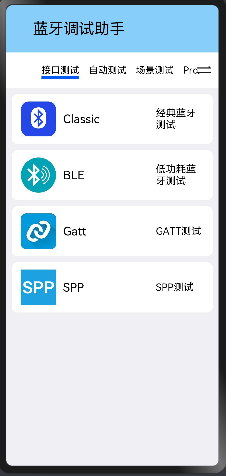
- 接口测试(ohos.bluetoothManager.d.ts)
>1. 经典蓝牙Manager模块接口测试
>
> BrManager功能界面使用说明文档.md
>
>2. BLE蓝牙Manager模块接口测试
>
> BLEManager功能界面使用说明文档.md
>
>3. GattManager模块接口测试
>
> GattManager功能界面使用说明文档.md
>
>4. SPPManager模块接口测试
>
> SPPManager功能界面使用说明文档.md
- 自动测试(ohos.bluetooth.d.ts)
>1. 经典蓝牙模块自动测试
>
>2. BLE蓝牙模块自动测试
>
>3. Gatt蓝牙模块自动测试
>
>4. SPP蓝牙模块自动测试
>
>5. Profile蓝牙模块自动测试
>
> 蓝牙自动测试使用说明文档.md
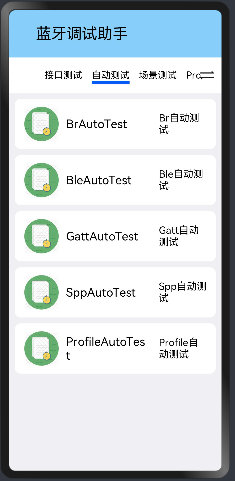
- 自动测试(ohos.bluetoothManager.d.ts)
>1. 经典蓝牙Manager自动测试
>
>2. BLE蓝牙Manager自动测试
>
>3. Gatt蓝牙Manager自动测试
>
>4. SPP蓝牙Manager自动测试
>
>5. Profile蓝牙Manager自动测试
>
> 蓝牙Manager自动测试使用说明文档.md
- 场景测试(ohos.bluetooth.d.ts)
>1. 经典蓝牙发现场景测试
>2. BLE蓝牙发现场景测试
>3. GattClient场景测试
>4. GattServer场景测试
>5. SppClient场景测试
>6. SppServer场景测试
>7. Opp发送端场景测试
>8. Opp接收端场景测试
>9. 蓝牙场景测试使用说明文档.md
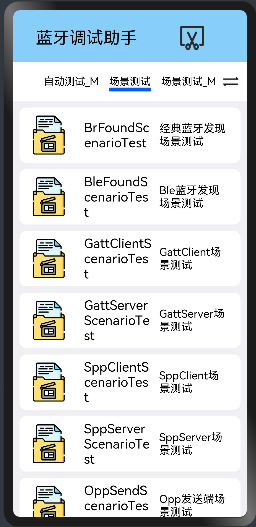
- 场景测试(ohos.bluetoothManager.d.ts)
>1. 经典蓝牙Manager发现场景测试
>
>2. BLE蓝牙Manager发现场景测试
>
>3. GattClientManager场景测试
>
>4. GattServerManager场景测试
>
>5. SppClientManager场景测试
>
>6. SppServerManager场景测试
>
> 蓝牙Manager场景测试使用说明文档.md
- Profile测试(ohos.bluetooth.d.ts)
>1. A2dpSourceProfile测试
>
>2. HandsFreeAudioGatewayProfile测试
>
>3. HidHostProfile测试
>
>4. PanNetwork测试
>
> Profile功能界面使用说明文档.md
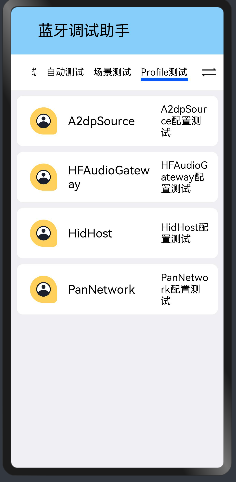
- Profile测试(ohos.bluetoothManager.d.ts)
>1. A2dpSourceProfileManager测试
>
>2. HandsFreeAudioGatewayProfileManager测试
>
>3. HidHostProfileManager测试
>
>4. PanNetworkManager测试
>
> ProfileManager功能界面使用说明文档.md
- 性能测试(ohos.bluetooth.d.ts)
>1. BrBenchmark测试
>
>2. BleBenchmark测试
>
>3. GattClientVelocityBenchmark / GattServerVelocityBenchmark测试
>
>4. SppClientVelocityBenchmark / SppServerVelocityBenchmark测试
>
>5. SppClientBandWidthBenchmark / SppServerBandWidthBenchmark测试
>
> 蓝牙性能测试功能界面使用说明文档.md
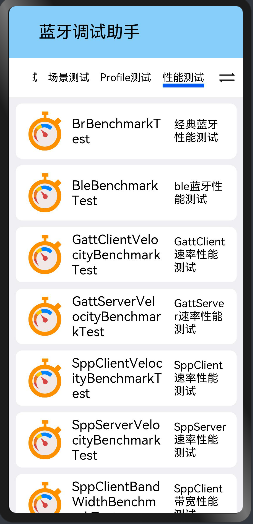
- 性能测试(ohos.bluetoothManager.d.ts)
>1. BrManagerBenchmark测试
>
>2. BleManagerBenchmark测试
>
>3. GattClientManagerVelocityBenchmark / GattServerManagerVelocityBenchmark测试
>
>4. SppClientManagerVelocityBenchmark / SppServerManagerVelocityBenchmark测试
>
>5. SppClientManagerBandWidthBenchmark / SppServerManagerBandWidthBenchmark测试
>
> 蓝牙Manager性能测试功能界面使用说明文档.md
程序烧录

---
### 安装使用说明(Open-Harmony)
在开源鸿蒙系统下
- 蓝牙专项应用程序路径为:foundation/communication/bluetooth/test/example/BluetoothTest
- 编译命令
~~~
# 全量编译
./build.sh --product-name {product_name}
# 单独编译HAP
./build.sh --product-name {product_name} --build-target BluetoothTest
- 生成文件
- 使用 find out -name "BluetoothTest.hap*" 查找生成文件,或者直接查看config.json所写的生成路径。
- 将生成文件拷到本地电脑上,连接板子,使用命令 `hdc_std.exe install BluetoothTest`进行安装。
- 使用命令 `hdc_std uninstall {安装包名}` 进行卸载。
- 安装包名在 `entry\src\main\config.json` 如:`"bundleName": "com.ohos.bttest"`
- 补充
在鸿蒙系统下编译,仍存在高版本对低版本的编译不兼容性问题。即在mater版本下编译的hap无法在beta2版本运行;反之则可以。
**要使用Opp文件传输功能,需要添加暴漏接口到本地DevEco的ohos.bluetooth.d.ts,才可以使用opp的接口**
- 修改ohos.bluetooth.d.ts中的 function ` getProfile`
~~~
/**
* Obtains the instance of profile.
*
* @param profileId The profile id..
* @return Returns instance of profile.
* @since 8
*/
function getProfile(profileId: ProfileId): A2dpSourceProfile | A2dpSinkProfile | AvrcpProfile | HandsFreeAudioGatewayProfile | HandsFreeUnitProfile | HidHostProfile | PanProfile | PbapClientProfile |OppProfile | PbapServerProfile ;
- 增加interface `OppProfile`
~~~
/**
* Manager OppProfile profile.
*/
interface OppProfile extends BaseProfile {
on(type: "transferStateChange", callback: Callback): void;
off(type: "transferStateChange"): void;
on(type: "receiveIncomingFile", callback: Callback): void;
off(type: "receiveIncomingFile"): void;
sendFile(device: string, filePaths: Array, mimeTypes: Array): boolean;
setIncomingFileConfirmation(accept: boolean): boolean;
getCurrentTransferInformation(): BluetoothOppTransferInformation;
cancelTransfer(): boolean;
}
~~~
---
### 程序说明
测试模块根据测试类型不同可以分为接口测试,自动化测试,场景测试,Profile测试,性能测试;
根据测试的接口仓不同可以分为bluetooth仓的测试与bluetoothManager仓的测试。
- 接口测试(ohos.bluetooth.d.ts)
>1. 经典蓝牙模块接口测试
>
> Br功能界面使用说明文档.md
>
>2. BLE蓝牙模块接口测试
>
> BLE功能界面使用说明文档.md
>
>3. Gatt模块接口测试
>
> Gatt功能界面使用说明文档.md
>
>4. SPP模块接口测试
>
> SPP功能界面使用说明文档.md
>

- 接口测试(ohos.bluetoothManager.d.ts)
>1. 经典蓝牙Manager模块接口测试
>
> BrManager功能界面使用说明文档.md
>
>2. BLE蓝牙Manager模块接口测试
>
> BLEManager功能界面使用说明文档.md
>
>3. GattManager模块接口测试
>
> GattManager功能界面使用说明文档.md
>
>4. SPPManager模块接口测试
>
> SPPManager功能界面使用说明文档.md
- 自动测试(ohos.bluetooth.d.ts)
>1. 经典蓝牙模块自动测试
>
>2. BLE蓝牙模块自动测试
>
>3. Gatt蓝牙模块自动测试
>
>4. SPP蓝牙模块自动测试
>
>5. Profile蓝牙模块自动测试
>
> 蓝牙自动测试使用说明文档.md

- 自动测试(ohos.bluetoothManager.d.ts)
>1. 经典蓝牙Manager自动测试
>
>2. BLE蓝牙Manager自动测试
>
>3. Gatt蓝牙Manager自动测试
>
>4. SPP蓝牙Manager自动测试
>
>5. Profile蓝牙Manager自动测试
>
> 蓝牙Manager自动测试使用说明文档.md
- 场景测试(ohos.bluetooth.d.ts)
>1. 经典蓝牙发现场景测试
>2. BLE蓝牙发现场景测试
>3. GattClient场景测试
>4. GattServer场景测试
>5. SppClient场景测试
>6. SppServer场景测试
>7. Opp发送端场景测试
>8. Opp接收端场景测试
>9. 蓝牙场景测试使用说明文档.md

- 场景测试(ohos.bluetoothManager.d.ts)
>1. 经典蓝牙Manager发现场景测试
>
>2. BLE蓝牙Manager发现场景测试
>
>3. GattClientManager场景测试
>
>4. GattServerManager场景测试
>
>5. SppClientManager场景测试
>
>6. SppServerManager场景测试
>
> 蓝牙Manager场景测试使用说明文档.md
- Profile测试(ohos.bluetooth.d.ts)
>1. A2dpSourceProfile测试
>
>2. HandsFreeAudioGatewayProfile测试
>
>3. HidHostProfile测试
>
>4. PanNetwork测试
>
> Profile功能界面使用说明文档.md

- Profile测试(ohos.bluetoothManager.d.ts)
>1. A2dpSourceProfileManager测试
>
>2. HandsFreeAudioGatewayProfileManager测试
>
>3. HidHostProfileManager测试
>
>4. PanNetworkManager测试
>
> ProfileManager功能界面使用说明文档.md
- 性能测试(ohos.bluetooth.d.ts)
>1. BrBenchmark测试
>
>2. BleBenchmark测试
>
>3. GattClientVelocityBenchmark / GattServerVelocityBenchmark测试
>
>4. SppClientVelocityBenchmark / SppServerVelocityBenchmark测试
>
>5. SppClientBandWidthBenchmark / SppServerBandWidthBenchmark测试
>
> 蓝牙性能测试功能界面使用说明文档.md

- 性能测试(ohos.bluetoothManager.d.ts)
>1. BrManagerBenchmark测试
>
>2. BleManagerBenchmark测试
>
>3. GattClientManagerVelocityBenchmark / GattServerManagerVelocityBenchmark测试
>
>4. SppClientManagerVelocityBenchmark / SppServerManagerVelocityBenchmark测试
>
>5. SppClientManagerBandWidthBenchmark / SppServerManagerBandWidthBenchmark测试
>
> 蓝牙Manager性能测试功能界面使用说明文档.md
 程序烧录

---
### 安装使用说明(Open-Harmony)
在开源鸿蒙系统下
- 蓝牙专项应用程序路径为:foundation/communication/bluetooth/test/example/BluetoothTest
- 编译命令
~~~
# 全量编译
./build.sh --product-name {product_name}
# 单独编译HAP
./build.sh --product-name {product_name} --build-target BluetoothTest
- 生成文件
- 使用 find out -name "BluetoothTest.hap*" 查找生成文件,或者直接查看config.json所写的生成路径。
- 将生成文件拷到本地电脑上,连接板子,使用命令 `hdc_std.exe install BluetoothTest`进行安装。
- 使用命令 `hdc_std uninstall {安装包名}` 进行卸载。
- 安装包名在 `entry\src\main\config.json` 如:`"bundleName": "com.ohos.bttest"`
- 补充
在鸿蒙系统下编译,仍存在高版本对低版本的编译不兼容性问题。即在mater版本下编译的hap无法在beta2版本运行;反之则可以。
**要使用Opp文件传输功能,需要添加暴漏接口到本地DevEco的ohos.bluetooth.d.ts,才可以使用opp的接口**
- 修改ohos.bluetooth.d.ts中的 function ` getProfile`
~~~
/**
* Obtains the instance of profile.
*
* @param profileId The profile id..
* @return Returns instance of profile.
* @since 8
*/
function getProfile(profileId: ProfileId): A2dpSourceProfile | A2dpSinkProfile | AvrcpProfile | HandsFreeAudioGatewayProfile | HandsFreeUnitProfile | HidHostProfile | PanProfile | PbapClientProfile |OppProfile | PbapServerProfile ;
- 增加interface `OppProfile`
~~~
/**
* Manager OppProfile profile.
*/
interface OppProfile extends BaseProfile {
on(type: "transferStateChange", callback: Callback
程序烧录

---
### 安装使用说明(Open-Harmony)
在开源鸿蒙系统下
- 蓝牙专项应用程序路径为:foundation/communication/bluetooth/test/example/BluetoothTest
- 编译命令
~~~
# 全量编译
./build.sh --product-name {product_name}
# 单独编译HAP
./build.sh --product-name {product_name} --build-target BluetoothTest
- 生成文件
- 使用 find out -name "BluetoothTest.hap*" 查找生成文件,或者直接查看config.json所写的生成路径。
- 将生成文件拷到本地电脑上,连接板子,使用命令 `hdc_std.exe install BluetoothTest`进行安装。
- 使用命令 `hdc_std uninstall {安装包名}` 进行卸载。
- 安装包名在 `entry\src\main\config.json` 如:`"bundleName": "com.ohos.bttest"`
- 补充
在鸿蒙系统下编译,仍存在高版本对低版本的编译不兼容性问题。即在mater版本下编译的hap无法在beta2版本运行;反之则可以。
**要使用Opp文件传输功能,需要添加暴漏接口到本地DevEco的ohos.bluetooth.d.ts,才可以使用opp的接口**
- 修改ohos.bluetooth.d.ts中的 function ` getProfile`
~~~
/**
* Obtains the instance of profile.
*
* @param profileId The profile id..
* @return Returns instance of profile.
* @since 8
*/
function getProfile(profileId: ProfileId): A2dpSourceProfile | A2dpSinkProfile | AvrcpProfile | HandsFreeAudioGatewayProfile | HandsFreeUnitProfile | HidHostProfile | PanProfile | PbapClientProfile |OppProfile | PbapServerProfile ;
- 增加interface `OppProfile`
~~~
/**
* Manager OppProfile profile.
*/
interface OppProfile extends BaseProfile {
on(type: "transferStateChange", callback: Callback